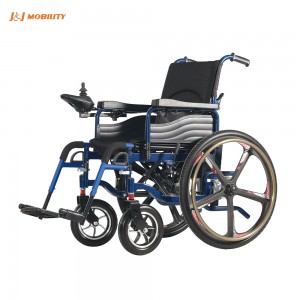What is the Difference Between Electromagnetic Brakes and Electronic Brakes?
As electric wheelchair technology continues to advance, the braking system, which is crucial for ensuring user safety, has garnered significant attention. Among the most common types of brakes are electromagnetic brakes and electronic brakes. Although their names are similar, their operating principles and application scenarios differ significantly. This article will provide a detailed analysis of the characteristics and distinctions between these two braking methods.
What is an Electromagnetic Brake?
An electromagnetic brake is a type of braking system that uses an electromagnet to control the friction pads. Its core principle relies on creating a magnetic field that attracts the brake pads, stopping the wheelchair’s motion. When the electric wheelchair loses power or comes to a halt, the electromagnetic brake automatically engages, locking the wheels to prevent unintended movement.
Characteristics:
High Safety: Electromagnetic brakes feature the “brake on power loss” characteristic, making them particularly suitable for slopes or uneven surfaces.
Simple Maintenance: They have a relatively simple structure and a long lifespan.
Stable Operation: The braking action is smooth, which does not cause additional wear on the wheelchair.
Application Scenarios:
Electromagnetic brakes are commonly used in heavy-duty wheelchairs or those that need to remain stationary for extended periods, especially ideal for heavier users or situations requiring frequent stops.
What is an Electronic Brake?
An electronic brake operates by adjusting the motor’s state to achieve braking. It typically relies on the control system to reverse the motor’s drive, slowing down or stopping the wheelchair’s movement.
Characteristics:
Quick Response: Electronic brakes depend on precise electronic control systems, offering extremely fast response times.
Comfortable Experience: They provide a smooth transition during deceleration, preventing discomfort for users caused by sudden stops.
Energy Efficient: Some electronic brake systems can recover kinetic energy during braking, extending the battery’s range.
Application Scenarios:
Electronic brakes are suitable for lightweight wheelchairs, particularly for users who prioritize responsiveness and riding smoothness.
Key Differences Between the Two
Braking Principle:
Electromagnetic brakes rely on mechanical locking.
Electronic brakes achieve deceleration or stopping through motor control.
Power Loss Behavior:
Electromagnetic brakes automatically lock when power is lost, providing an additional safety measure.
Electronic brakes require power; they may lose braking function in the event of a power outage.
User Experience:
Electromagnetic brakes are better suited for static stopping scenarios and provide strong braking force.
Electronic brakes focus on dynamic control, suitable for frequent starts and stops.
How to Choose the Right Braking System?
When deciding between electromagnetic and electronic brakes, consider your usage scenario and personal needs. If you frequently navigate slopes or complex terrains, an electromagnetic brake is the safer choice. Conversely, for users who prioritize smooth driving and mainly use their wheelchairs on flat surfaces, an electronic brake may be more suitable.
Post time: Nov-26-2024


